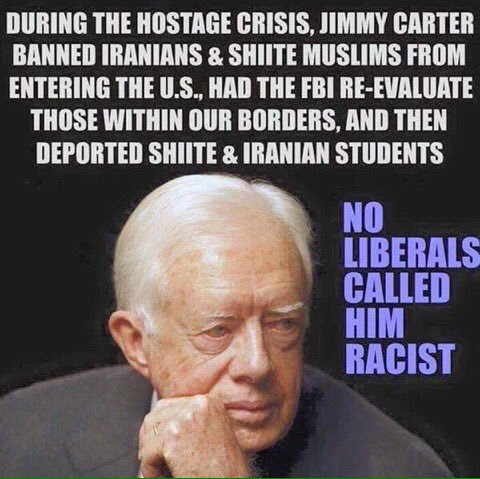 Not that we would want President Donald Trump to be anything like the president that peanut grower, Jimmy Carter was, but President Trump sure could use the same level of support for his attempts to protect the United States from Radical Islamic Terrorism that President Jimmy got.
Not that we would want President Donald Trump to be anything like the president that peanut grower, Jimmy Carter was, but President Trump sure could use the same level of support for his attempts to protect the United States from Radical Islamic Terrorism that President Jimmy got.
From Aljazeera (I know, but I don’t make the news), “this is not the first time that the US has banned immigrants from its shores. Over the past 200 years, successive American presidents have placed restrictions on the immigration of certain groups.”
Here are six occasions when laws have been passed to restrict some people from entering the country.
1. Exclusion of the Chinese – President Chester A. Arthur.
Signed on May 6, 1882.
The Chinese Exclusion Act, which banned “skilled and unskilled labourers and Chinese employed in mining” from entering the US for 10 years, was the first significant law restricting immigration to the country. It came at a time when the US was struggling with high unemployment and, although Chinese made up a very small segment of the country’s workforce, they were nevertheless scapegoated for its social and economic woes.
2. Jewish refugees during World War II – President Franklin D. Roosevelt.
As millions of people became refugees during World War II, US President Franklin D Roosevelt argued that refugees posed a serious threat to the country’s national security. Drawing on fears that Nazi spies could be hiding among them, the country limited the number of German Jews who could be admitted to 26,000 annually. And it is estimated that for most of the Hitler era, less than 25 percent of that quota was actually filled.
3. Anarchists banned – President Theodore Roosevelt.
Signed on March 3, 1903.
In 1903, the Anarchist Exclusion Act banned anarchists and others deemed to be political extremists from entering the US.
In 1901, President William McKinley had been fatally shot by Leon Czolgosz, an American anarchist who was the son of Polish immigrants.
The act – which was also known as the Immigration Act of 1903 – codified previous immigration law and, in addition to anarchists, added three other new classes of people who would be banned from entry: those with epilepsy, beggars and importers of prostitutes.
4. Communists banned – Passed by Congress on August 23, 1950, despite being vetoed by President Harry Truman .
The Internal Security Act of 1950 – also known as the Subversive Activities Control Act of 1950 or the McCarran Act – made it possible to deport any immigrants believed to be members of the Communist Party. Members of communist organisations, which were required to register, were also not allowed to become citizens.
5. Iranians – President Jimmy Carter,
April 7, 1980.
Following the 1979 Iranian hostage crisis, during which the US embassy in Tehran was stormed and 52 Americans were held hostage for 444 days, American President Jimmy Carter cut diplomatic relations with and imposed sanctions on Iran. He also banned Iranians from entering the country.
6. Ban on HIV positive persons – Under President Ronald Reagan, the US Public Health Service added Aids to its list of “dangerous and contagious” diseases. Senator Jesse Helms’ “Helms Amendment” added HIV to the exclusion list.
In 1987, the US banned HIV positive persons from arriving in the US. The laws were influenced by homophobic and xenophobic sentiment towards Africans and minorities at the time, as well as a false belief that the HIV virus could be spread by physical or respiratory contact. Former US President Barack Obama lifted it in 2009, completing a process begun by President George W Bush.

